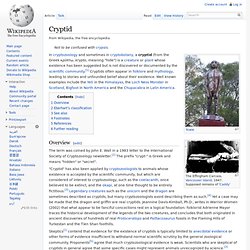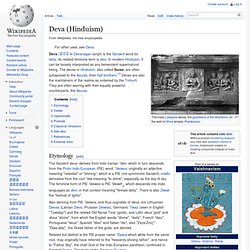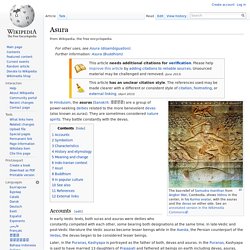

Cryptid. In cryptozoology and sometimes in cryptobotany, a cryptid (from the Greek κρύπτω, krypto, meaning "hide") is a creature or plant whose existence has been suggested but is not discovered or documented by the scientific community.[1] Cryptids often appear in folklore and mythology, leading to stories and unfounded belief about their existence.

Well known examples include the Yeti in the Himalayas, the Loch Ness Monster in Scotland, Bigfoot in North America and the Chupacabra in Latin America. Overview[edit] The term was coined by John E. Wall in a 1983 letter to the International Society of Cryptozoology newsletter.[2] The prefix "crypt-" is Greek and means "hidden" or "secret". Skeptics[1] contend that evidence for the existence of cryptids is typically limited to anecdotal evidence or other forms of evidence insufficient to withstand normal scientific scrutiny by the general zoological community. Eberhart's classification[edit] George M. Insignificance. See also[edit] [edit] References[edit] Trimurti. Evolution[edit] An art depiction of the Trimurti at the Hoysaleswara temple in Halebidu.

Trimurti, painting from Andhra Pradesh The Puranic period saw the rise of post-Vedic religion and the evolution of what R. C. Majumdar calls "synthetic Hinduism This period had no homogeneity, and included orthodox Brahmanism in the form of remnants of older Vedic faith traditions, along with different sectarian religions, notably Shaivism, Vaishnavism, and Shaktism that were within the orthodox fold yet still formed distinct entities.[6] One of the important traits of this period is a spirit of harmony between orthodox and sectarian forms.[7] Regarding this spirit of reconciliation, R. Its most notable expression is to be found in the theological conception of the Trimūrti, i.e., the manifestation of the supreme God in three forms of Brahmā, Viṣṇu, and Śiva... Historian A. Early western students of Hinduism were impressed by the parallel between the Hindu trinity and that of Christianity. Deva (Hinduism) Deva (देव in Devanagari script) is the Sanskrit word for deity, its related feminine term is devi.

In modern Hinduism, it can be loosely interpreted as any benevolent supernatural being. The devas in Hinduism, also called Suras, are often juxtaposed to the Asuras, their half brothers.[1] Devas are also the maintainers of the realms as ordained by the Trimurti. They are often warring with their equally powerful counterparts, the Asuras. The Sanskrit deva- derives from Indo-Iranian *dev- which in turn descends from the Proto-Indo-European (PIE) word, *deiwos, originally an adjective meaning "celestial" or "shining", which is a PIE (not synchronic Sanskrit) vrddhi derivative from the root *diw meaning "to shine", especially as the day-lit sky.
The feminine form of PIE *deiwos is PIE *deiwih2, which descends into Indic languages as devi, in that context meaning "female deity". The Vedas, the earliest comprehensive literature, contain mantras for pleasing the devas to obtain blessings. Asura. Accounts[edit] In early Vedic texts, both suras and asuras were deities who constantly competed with each other, some bearing both designations at the same time.

In late-Vedic and post-Vedic literature the Vedic asuras became lesser beings while in the Avesta, the Persian counterpart of the Vedas, the devas began to be considered lesser beings. Later, in the Puranas, Kashyapa is portrayed as the father of both, devas and asuras. In the Puranas, Kashyapa is said to have married 13 daughters of Prajapati and fathered all beings on earth including devas, asuras, manavas and the entire animal world.[1] Symbolism[edit] Alain Daniélou says: It is significant that it was not for their sins that the anti-gods had to be destroyed but because of their power, their virtue, their knowledge, which threatened that of the gods—that is, the gods of the Aryas.
Alain Daniélou explains the nature of social division between the devas and asuras; and the subsequent assimilation thus: Characteristics[edit] P.L. Avalon. In Search Of Myths and Heroes - King Arthur.